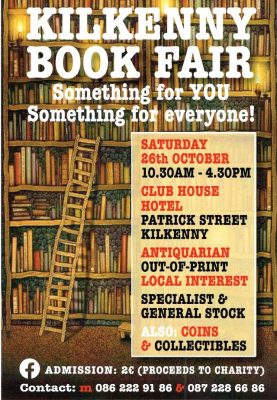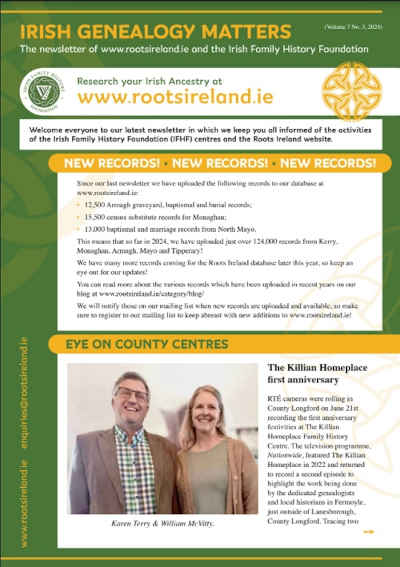
Scheduled Maintenance
New Kerry Records Added!
We are delighted to announce the addition of 13,049 Roman Catholic baptismal records from the parish of Castlegregory, Co. Kerry, dating from 1828-1899 to our database at Roots Ireland! For an up to date list of sources for Kerry and to search these records, go to kerry.rootsireland.ie and login or subscribe as required.
New Issue of Irish Genealogy Matters Published
We are delighted to announce the publication of our latest issue of ‘Irish Genealogy Matters’, in which we keep our readers abreast of all of the latest developments in the Irish Family History Foundation and new records online! Click on the image above to read the newsletter in full. We hope you enjoy!
Special Offer – 25% off annual subscriptions!
Discover your Irish roots by taking out a 12-month subscription for Roots Ireland with a 25% discount from 2nd September to 17th September 2024!*

To avail of this offer just go to the following link and login using your existing RootsIreland login details: http://www.rootsireland.ie. If you currently have a subscription, click My Account, My Subscription and Start a New Subscription. The special deal subscription will then begin once your current subscription runs out.
Why take out a subscription with RootsIreland?
- RootsIreland have the most complete and most accurate set of Roman Catholic church records online. Our index is easily searchable and has features such as standardised surname and forename searches which make your searches even more user-friendly.
- We hold over 23 million records which is being added to continually. In 2024 so far, we have added over 124,000 records to our database from Kerry, Armagh, Tipperary, Mayo and Monaghan. New records are continually being added to our database throughout the year.
- Together, our 34 genealogy centres have an unparalleled amount of local knowledge which can be invaluable to those tracing their ancestors, a service which no other website or company can provide to such a high standard. By taking out a subscription with RootsIreland, you are helping these centres to continue to provide a world-class service and securing many Irish jobs.
If you have any questions please check our Help section and if this does not provide an answer, then you may contact us or one of the county centres. You can check what is available on our site for each county here.
*Offer applies from 2 September 2024 to 12 midnight Irish time on 17 September 2024 only. Cannot be used in conjunction with any other offer.
New Armagh records added!
We are delighted to announce the addition of almost 12,500 new Armagh graveyard, baptismal and burial records to the Roots Ireland database! They are as follows:
Graveyards:
New Monaghan Records Added!
We are delighted to announce the addition to the Roots Ireland database of almost 15,500 census substitute records for County Monaghan! These records are as follows:
| Grand Jury Bills County Monaghan Assizes, 1794-1831 | (13002 records) |
| 1794-1831 Newspaper Reports Monaghan Assizes | (1843 records) |
| Aghabog Church of Ireland Survey, 1824 | (144 records) |
| Subscribers Poor Man’s Dinner Monaghan, 1853 | (133 records) |
| 1884-1919 Bragan Boys National School Register (Boys) | (360 records) |
For an up to date list of sources for Monaghan and to search these records, go to https://rootsireland.ie/
New Mayo Records
We are delighted to announce the addition of over 13,000 new Roman Catholic baptismal and marriage records from North Mayo. These latest additions bring the majority of North Mayo Roman Catholic parish records available on rootsireland.ie up to the year 1923. The added records are listed below. For an up to date list of sources for North Mayo and to search these records, go to mayo.rootsireland.ie and login or subscribe as required.
| R.C. Parish | Existing baptism record dates | New baptism record dates |
| Addergoole | 1840-1920 | 1920-1923 |
| Ardagh | 1866-1914 | 1914-1923 |
| Attymass | 1875-1920 | 1920-1923 |
| Backs/Knockmore | 1830-1914 | 1914-1915 |
| Ballycastle | 1858-1914 | 1914-1923 |
| Ballycroy | 1890-1914 | 1914-1916 |
| Ballysakerry/Cooneal | 1843-1914 | 1914-1923 |
| Bohola | 1857-1920 | 1920-1923 |
| Carracastle | 1853-1920 | 1920-1923 |
| Crossmolina | 1831-1914 | 1914-1923 |
| Kilbeagh/Charlestown | 1855-1920 | 1920-1923 |
| Kilcommon Erris | 1860-1914 | 1914-1916 |
| Kilconduff/Swinford | 1822-1920 | 1920-1922 |
| Killala | 1852-1914 | 1914-1920 |
| Kilmoremoy/Ballina | 1823-1836
1841-1846 1849 1851-1914 |
1914-1919 |
| Kiltane | 1860-1914 | 1914-1923 |
| Moygownagh | 1877-1914 | 1914-1923 |
| Templemore/Straide | 1888-1920 | 1920-1923 |
| Toomore (Foxford) | 1871-1920 | 1920-1926 |
| Turlough/Park | 1847-1914 | 1914-1923 |
| R.C. Parish | Existing marriage record dates | New marriage record dates |
| Addergoole | 1840-1920 | 1920-1923 |
| Ardagh | 1882-1911 | 1911-1923 |
| Attymass | 1874-1920 | 1920-1923 |
| Backs/Knockmore | 1815-1911 | 1911-1923 |
| Ballycastle | 1869-1911 | 1911-1923 |
| Ballycroy | 1890-1911 | 1911-1923 |
| Ballysakerry/Cooneal | 1843-1911 | 1911-1923 |
| Bohola | 1857-1920 | 1920-1923 |
| Carracastle | 1847-1903 | 1920-1923 |
| Crossmolina | 1831-1840 | 1916-1923 |
| Kilcommon Erris | 1843-1848
1900-1911 |
1911-1923 |
| Kilconduff/Swinford | 1808-1839
1842-1878 1900-1911 |
1920-1922 |
| Kilfian | 1826-1836
1900-1911
|
1911-1923 |
| Kilgarvin/Bonniconlon | 1844-1881
Sporadic 1842-1878 1900-1911 |
1911-1923 |
| Killala | 1873-1911 | 1911-1923 |
| Kilmore Erris | 1860-1911 | 1911-1914 |
| Kilmoremoy/Ballina | 1823-1836 | 1914-1921 |
| Kiltane | 1860-1920 | 1920-1923 |
| Moygownagh | 1881-1920 | 1920-1923 |
| Templemore/Straide | 1881-1920 | 1920-1923 |
| Toomore (Foxford) | 1833-1840
Sporadic 1870-1918 |
1918-1923 |
| Turlough/Park | 1822-1823
1848-1920 |
1920-1923 |
- 1
- 2
- 3
- …
- 32
- Next Page »
